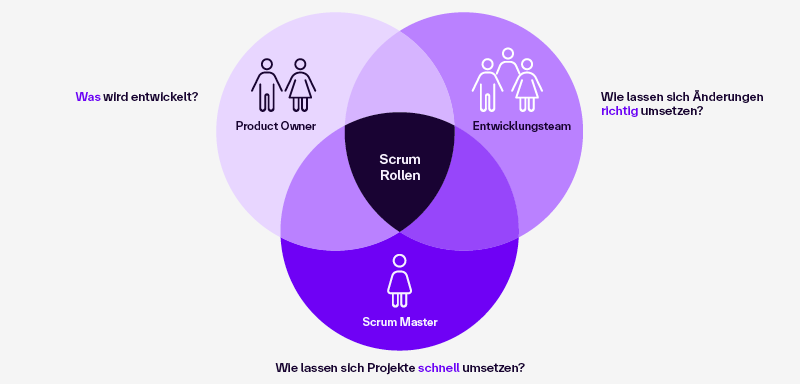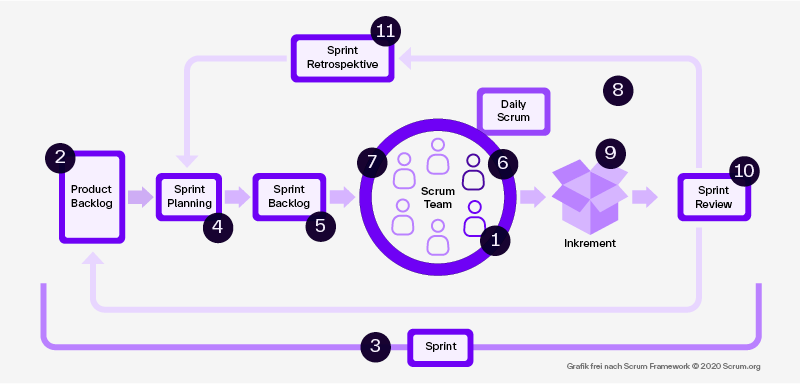Scrum ist eine agile Projektmanagementmethode, die insbesondere in der Softwareentwicklung weit verbreitet ist, weil iterative Sprints schrittweise Verbesserungen ermöglichen. Zunehmend findet sie auch in anderen Branchen Anwendung. Besonders geeignet ist sie für Teams, die enormen Kundenfokus anstreben und für die schnelle Entwicklung von Produkten und deren kontinuierliche Verbesserung verantwortlich sind.
Wenn man Mitglied eines Produkt-, Entwicklungs- oder Software-Entwicklungsteams ist oder mit einem solchen Team zusammenarbeitet, hat man wahrscheinlich schon einmal von Scrum gehört und fragt sich vielleicht: Was ist Scrum und wie funktioniert diese Methode?
Kurz gesagt: Scrum eignet sich als Framework für Teams, die Produkte schnell entwickeln und verbessern wollen. Die Einführung solcher Prozesse kann dabei helfen, komplexe Probleme gemeinsam zu lösen. Aber auch wenn man nicht in einem Produkt-, Entwicklungs- oder Softwareentwicklungsteam arbeitet, kann man von dieser Methode profitieren. In diesem Artikel wird die Scrum-Methode näher erläutert und es wird alles Wichtige darüber erklärt.
Definition – Was ist Scrum?
Scrum ist eine Projektmanagementmethode, die sich besonders für Teams eignet, die Produkte schnell entwickeln und kontinuierlich verbessern wollen. Dabei stellt Scrum einen Leitfaden mit Werten, Rollen und Prinzipien zur Verfügung, an dem sich das Team orientieren kann. Im Mittelpunkt von Scrum stehen die sogenannten Sprints. Diese können unterschiedlich lang sein, meist zwischen einer und vier Wochen.
Neben den Sprints gibt es vier wichtige Ereignisse:
- Sprint-Planning: Zu Beginn eines Sprints legt das Team gemeinsam fest, welche Aufgaben bearbeitet werden. Es bewertet die Prioritäten im Product Backlog und schätzt den Aufwand für jede Aufgabe. Ziel ist es, ein realistisches Sprint-Ziel zu setzen und die Arbeit so zu planen, dass sie abgeschlossen werden kann.
- Tägliche Stand-ups: Wie der Name schon verrät, handelt es sich bei den Dailys oder Daily Scrums um 15-minütige Meetings, die einmal pro Tag abgehalten werden. Der Zweck ist, Updates zu teilen, Aktivitäten für den Tag zu planen und um Hindernisse – sogenannte Impediments – zu identifizieren, die den Fortschritt blockieren könnten
- Sprint-Retrospektiven: Diese regelmäßigen Meetings finden nach Abschluss eines Sprints statt. Im Team wird auf den vergangenen Sprint geblickt und es wird gemeinsam reflektiert, was gut gelaufen ist und was nicht. Die strukturierte Vorgehensweise unterstützt das Team darin Probleme frühzeitig zu erkennen und zu lösen und sowohl den Arbeitsprozess als auch das Produkt kontinuierlich zu verbessern.
- Sprint-Review: Das Sprint Review findet stets am Ende eines Sprints statt. Dabei werden die wesentlichen Ergebnisse vorgestellt, überprüft und bei Bedarf angepasst. Dies sorgt für Transparenz bezüglich des aktuellen Produktinkrements und das Product Backlog wird entsprechend angepasst.
Historie der Scrum-Methode
- 1995: Jeff Sutherland und Ken Schwaber präsentierten erstmals Scrum auf der OOPSLA-Konferenz (Object-Oriented Programming, Systems, Languages & Applications).
- 2001: Beide trugen zur Erstellung des Agile Manifests bei, einem grundlegenden Dokument, das die Prinzipien und Werte agiler Methoden festlegte.
- 2002: Gründung der Scrum Alliance, einer Organisation, die Schulungen und Zertifizierungen für Scrum anbietet.
- 2010: Veröffentlichung des ersten offiziellen Scrum Guides, der die Regeln und Prinzipien von Scrum definiert.
- Seit 2010 wird der Scrum Guide regelmäßig aktualisiert. Z.B. ist im Laufe der Jahre, der Begriff „Development Team“ entfernt worden.
Die Grundlagen von Scrum
Die Rollen innerhalb von Scrum
Product Owner: Ist verantwortlich für das Product Backlog und die Backlog-Einträge, kennt die Anforderungen an das Produkt oder das Projekt und hält das Team darüber auf dem Laufenden. Gute Product Owner schaffen Klarheit über Prioritäten und entscheiden, wann etwas fertig für die Bereitstellung ist. Zu den Aufgaben gehören: Entwickeln und Kommunizieren des Produktziels, Erstellen und Klären von Backlog-Einträgen, Priorisieren des Backlogs und Sicherstellen von Transparenz. Eine Zertifizierung wie der „Professional Scrum Product Owner“ vertieft und formalisiert diese Fähigkeiten.
Scrum Master: Der Scrum Master coacht, organisiert und vermittelt. Seine Hauptaufgabe ist es, das Scrum-Team zu unterstützen, Hindernisse zu beseitigen und sicherzustellen, dass Scrum korrekt angewendet wird. Gleichzeitig unterstützt er den Product Owner bei der Produktzieldefinition und dem Backlogmanagement sowie die Organisation bei der Scrum-Implementierung. Dazu ist ein tieferes Verständnis der Methode erforderlich, das im Rahmen von Fort- und Weiterbildungen erworben werden kann.
Scrum Team: Das Scrum-Team besteht aus dem Entwicklungsteam, dem Scrum Master und dem Product Owner, die eng zusammenarbeiten, um das Projektziel zu erreichen. Dabei besteht das Team aus allen Personen, die Aufgaben zu erledigen haben, also nicht nur den Entwicklern. Während die Stakeholder nicht Teil des Scrum-Teams sind, spielen sie eine wichtige Rolle, insbesondere bei der Sprint Review, wo sie Feedback geben. Zu den Aufgaben des Teams gehören die Erstellung der Sprint-Pläne, die täglichen Anpassungen im Daily Scrum, die Umsetzung der Backlog-Aufgaben und die kontinuierliche Verbesserung durch Retrospektiven. Dabei wird das Feedback der Stakeholder in den Entwicklungsprozess integriert.

Überblick über die Grundprinzipien von Scrum
Die Grundprinzipien von Scrum basieren im Wesentlichen auf drei Säulen: Transparenz, Inspektion und Anpassung. Diese Prinzipien stellen sicher, dass alle Aspekte des Scrum-Prozesses für alle Beteiligten sichtbar sind, regelmäßig überprüft und bei Bedarf angepasst werden. Die Prinzipien sehen wie folgt aus:
- Transparenz: Alle Prozessaspekte müssen sichtbar und für jeden verständlich sein. Dies bedeutet, dass das Team klare und offene Kommunikation pflegt und alle Arbeitsschritte, Fortschritte und Probleme für alle Beteiligten zugänglich sind.
- Inspektion: Regelmäßige Überprüfungen der Fortschritte und Anpassungen an den Plan, um den aktuellen Anforderungen gerecht zu werden. Dies erfolgt durch formelle Ereignisse wie das Sprint Review und die Sprint Retrospektive.
- Anpassung: Anhand der gewonnenen Erkenntnisse werden stetig Prozesse angepasst und verbessert. Auf diese Art und Weise bleibt das Team flexibel und ist bereit, seine Arbeitsweise ständig zu verbessern.

Unsere Empfehlung
Zertifizierungstraining Scrum Master
Scrum ist das wohl bekannteste Vorgehensmodell des agilen Projektmanagements. Kurze Arbeitszyklen, häufige Feedback-Schleifen und selbstorganisierte Teams sind die prägenden Merkmale. Der Scrum Master vermittelt die Methoden und Ansätze der agilen Projektarbeit und unterstützt das Team dabei, seine volle Wirksamkeit zu entfalten. Die Scrum Master Zertifizierung (die Prüfungsgebühr zum Professional Scrum Master® nach Scrum.org* ist im Seminarpreis bereits inbegriffen) bringt Sie und Ihr Team entscheidend weiter.
Training: Zertifizierungstraining Scrum Master
Die Scrum-Werte
Darüber hinaus wird das Team von den fünf zentralen Scrum-Werten – Engagement, Mut, Fokus, Offenheit und Respekt – geleitet, die eine reibungslose Zusammenarbeit fördern und sicherstellen, dass die Erreichung der Projektziele im Mittelpunkt steht. Das Team ist über diese Werte informiert und sorgt dafür, dass sie in der täglichen Arbeit eingehalten werden.
- Engagement: Scrum-Teams arbeiten als Einheit zusammen, wobei jedes Mitglied aktiv an der Sprintplanung beteiligt ist. Unrealistische Aufgaben und Zeitpläne werden durch gemeinsames Engagement und Offenheit vermieden.
- Mut: Innovation erfordert Mut und Vertrauen in die eigenen Fähigkeiten. Mut kann sich aber auch in der Fähigkeit zeigen, unrealistische Anfragen abzulehnen. Projektmanager, die ehrliche Diskussionen fördern und Herausforderungen transparent angehen, motivieren die Teammitglieder und machen Kundenzufriedenheit sowie Projekterfolg wahrscheinlicher.
- Schwerpunkt: Um qualitativ hochwertige Sprints pünktlich abzuliefern, ist Konzentration auf die wichtigen Aufgaben notwendig, um die Projektziele zuverlässig zu erreichen. Das erreicht das Team durch ein Arbeiten mit Scrum.
- Offenheit: Ehrliche Kommunikation und Offenheit im Scrum-Team ist essenziell für den Projekterfolg. Transparente Kommunikation fördert das Teilen von Erfolgen, das Hinterfragen von Rückschlägen und Diskussionen darüber reduziert Fehler.
- Respekt: Unterschiedliche Meinungen und Vielfalt im Team sind wertvoll. Respekt zeigt sich durch die Wertschätzung individueller Unterschiede und Meinungen. Teams, die sich respektieren und unterstützt fühlen, haben eine positivere Einstellung und teilen eher ihre Ideen, was zu besseren Ergebnissen führen kann.
Die Scrum-Artefakte
Bei den Scrum-Artefakten handelt es sich um spezifische Dokumente und Werkzeuge, die im Scrum-Framework verwendet werden, um den Fortschritt und die Anforderungen eines Projekts zu verwalten und zu visualisieren. Die drei wichtigsten Scrum-Artefakte sind:
- Produkt-Backlog: Eine Liste aller Produktanforderungen, einschließlich Features, Funktionen, Verbesserungen und Fehlerbehebungen, die zukünftige Sprints umsetzen sollen. Als Verantwortlicher pflegt und priorisiert der Product Owner den Produkt-Backlog, um sicherzustellen, dass das Team an den wertvollsten Aufgaben arbeitet.
- Sprint-Backlog: Eine Liste von Aufgaben, die das Scrum-Team während eines Sprints umsetzen möchte. Er wird während des Sprint-Planning-Meetings erstellt und dient als Plan für den Sprint. Der Sprint-Backlog wird kontinuierlich aktualisiert, um Fortschritt zu verfolgen und Anpassungen vorzunehmen. Dadurch bleibt das Team fokussiert und organisiert.
- Produkt-Inkrement: Das Ergebnis eines Sprints, das alle umgesetzten Aufgaben und Funktionen umfasst, die den Kriterien „fertig“ entsprechen, nennt man Produkt-Inkrement. Es muss in einem nutzbaren Zustand sein und den Anforderungen des Produkt-Backlogs entsprechen. Am Ende jedes Sprints sollte ein neues, potenziell auslieferbares Inkrement des Produkts vorliegen, was kontinuierliche Verbesserung und Erweiterung ermöglicht.
Der Scrum-Prozess und seine Ereignisse
Scrum-Ereignisse kann man sich wie präzise getaktete Haltestellen einer Zugreise vorstellen. Diese Ereignisse sind zeitlich begrenzt (Time-Box) und bieten Gelegenheit, die Projekt-Artefakte wie Fahrkarten zu überprüfen und dem Fahrtziel stetig anzupassen. Das schafft Transparenz und minimiert die Notwendigkeit zusätzlicher Stopps. So wie ein Zug, der immer an den gleichen Stationen hält, reduzieren festgelegte Routine das gesamte Projekt. Das Team weiß genau, wann und wo es zusammenkommt, um den eigenen Kurs, die Fahrtrichtung – zu überprüfen.
Die Schritte vor dem Sprint
- Produktvision
Der Product Owner arbeitet mit Stakeholdern zusammen, um eine klare Vision und langfristige Ziele für das Produkt zu definieren. Dazu ist der Stakeholder-Input wichtig. Also Anforderungen, Wünsche und Probleme. Dies gibt dem Team eine Richtung und einen Rahmen für die Arbeit.- Erstellen des Product Backlog
Der Product Owner beginnt damit, kurze Beschreibungen von Funktionalitäten des Produkts im Backlog zu sammeln. Später werden diese dann, im besten Fall aus der Perspektive des Kunden betrachtet, anhand dieser priorisiert und in eine Reihenfolge gebracht.
Der Sprint
- Dauer: Meistens zwei Wochen, maximal 30 Tage.
- Ziel: Fokus auf die Erledigung der im Sprint-Planungs-Meeting festgelegten Aufgabenpakete aus dem Backlog.
- Prozess: Während des Sprints arbeitet das Team an den Aufgaben aus dem Backlog, die im Sprint-Planungs-Meeting festgelegt wurden. Obwohl die Sprint-Ziele stabil bleiben sollten, können sich die Aufgaben im Sprint-Backlog ändern, wenn das Team feststellt, dass Anpassungen notwendig sind. Wichtig ist, dass die Sprint-Ziele möglichst unverändert bleiben, um den Fokus des Teams zu bewahren.
- Teilnehmer: Das gesamte Scrum-Team.
Sprint Planning
- Dauer: Acht Stunden für einen Sprint von 30 Tagen und vier Stunden für einen Sprint von zwei Wochen.
- Ziel: Festlegung der im Sprint auszuführenden Arbeiten.
- Prozess: Der Product Owner beschreibt das Ziel des Sprints und benennt die relevanten Backlog-Elemente. Das Entwicklerteam plant die Aufgaben zur Erreichung des Sprint-Ziels. Das Ergebnis ist ein Sprint-Plan, der das Sprint-Ziel und den Weg dorthin beschreibt.
- Teilnehmer: Das gesamte Scrum-Team. Auf Grundlage des Produkt-Backlog und den verfügbaren stehenden Kapazitäten des Teams wird der Sprintplan erstellt.
Daily Scrum
- Dauer: Maximal 15 Minuten täglich.
- Ziel: Überprüfung des Fortschritts in Richtung Sprint-Ziel und Anpassung des Sprint Backlogs bei Bedarf.
- Prozess: Die Entwickler tauschen sich über den aktuellen Arbeitsfortschritt aus und identifizieren mögliche Hindernisse.
- Teilnehmer: Entwicklerteam.
Sprint Review
- Dauer: Maximal vier Stunden.
- Ziel: Überprüfung der Arbeitsergebnisse und Festlegung zukünftiger Anpassungen des Product Backlogs auf Basis des Feedbacks.
- Prozess: Das Scrum-Team präsentiert die Arbeitsergebnisse den wichtigsten Stakeholdern und diskutiert die Fortschritte in Richtung Produkt-Ziel.
- Teilnehmer: Scrum-Team und Stakeholder.
Sprint Retrospektive
- Dauer: Maximal drei Stunden.
- Ziel: Reflexion über den vergangenen Sprint und Identifizierung von Verbesserungsmöglichkeiten für den kommenden Sprint.
- Prozess: Das Scrum-Team bespricht, was gut gelaufen ist und wo Verbesserungspotenzial besteht, um kontinuierliche Verbesserungen im Scrum-Prozess zu erzielen.
- Teilnehmer: Das gesamte Scrum-Team.
Vorteile und Herausforderungen von Scrum
Die Scrum-Methode bietet zahlreiche Vorteile, darunter verbesserte Zusammenarbeit und eine Kultur der offenen Kommunikation. Regelmäßige Meetings, wie das Daily Scrum, fördern den Informationsaustausch und die Arbeitskoordination, was zu erhöhter Transparenz und Vertrauen innerhalb des Teams führt. Klare Rollen und Verantwortlichkeiten helfen, Missverständnisse zu vermeiden und die Effizienz zu steigern.
Scrum ermöglicht außerdem flexible und schnelle Reaktionen auf Veränderungen durch die Nutzung kurzer, iterativer Sprints. Dies erlaubt Teams, ihre Arbeit regelmäßig zu überprüfen und anzupassen, was frühzeitiges Feedback und notwendige Anpassungen ermöglicht.
Jedoch stehen Teams auch vor Herausforderungen wie Widerstand gegen Veränderungen und Missverständnissen über die Rollenverteilung. Eine unzureichende Schulung kann dazu führen, dass die Scrum-Prinzipien nicht korrekt umgesetzt werden. Regelmäßige Fortbildungen und die Unterstützung durch erfahrene Scrum Master sind essenziell, um diese Herausforderungen zu bewältigen und die Vorteile von Scrum voll auszuschöpfen.
5 Tipps für die Einführung von Scrum
- Schulungen anbieten: Investieren Sie in Scrum-Schulungen und Zertifizierungen, um sicherzustellen, dass das Team die Prinzipien und Praktiken von Scrum versteht und selbstgesteuert anwenden kann.
- Pilotprojekt starten: Beginnen Sie mit einem kleinen, überschaubaren Projekt, um erste Erfahrungen zu sammeln und Anpassungen vorzunehmen.
- Management einbeziehen: Stellen Sie sicher, dass das Management oder Stakeholder die Einführung von Scrum unterstützt und aktiv fördert.
- Regelmäßige Retrospektiven: Nutzen Sie Sprint-Retrospektiven, um kontinuierlich Feedback zu sammeln und Verbesserungen umzusetzen.
- Transparenz fördern: Sorgen Sie für offene Kommunikation und sichtbare Fortschritte durch regelmäßige Meetings und ein gut gepflegtes Product-Backlog.
Ausblick und Trends von Scrum
Für die Zukunft von Scrum zeichnen sich mehrere Trends ab, die bis 2030 relevant sein werden:
- Zum einen wird eine zunehmende Integration von Künstlicher Intelligenz (KI) in Scrum-Prozesse erwartet, um die Entscheidungsfindung und Effizienz zu verbessern. Zum Beispiel historische Daten und Nutzer-Feedback analysieren, um die Priorisierung von Backlog-Items zu optimieren. Auch ist denkbar, dass neue Backlog-Items generiert werden, basierend auf Marktanalysen, Nutzerverhalten und Trends.
- Zum anderen werden digitale Tools immer wichtiger, insbesondere für Remote-Teams, um die Zusammenarbeit und Kommunikation zu erleichtern.
- Ebenfalls könnte sich die Anwendung von Scrum über die Softwareentwicklung hinaus auf andere Bereiche wie Marketing und Produktmanagement ausweiten.
Hier finden Sie unsere Weiterbildungsangebote: SCRUM-Weiterbildung
FAQ: Scrum
Wie lange dauert ein typischer Sprint?
Ein Sprint dauert normalerweise zwei bis vier Wochen. Die genaue Länge kann jedoch je nach Projekt und Teambedürfnissen variieren. Wichtig ist, dass die Sprintlänge konstant bleibt, sobald sie festgelegt ist.
Wer sind die Hauptakteure in einem Scrum-Team?
Ein Scrum-Team besteht typischerweise aus dem Product Owner, dem Scrum Master und den Entwicklern, im Scrum Guide „Developer:innen“ genannt. Der Product Owner ist für die Definition der Produktvision und die Priorisierung des Backlogs verantwortlich. Der Scrum Master unterstützt das Team dabei, Scrum-Prozesse effektiv zu nutzen. Die Developer:innen sind für die Ausführung der Aufgaben verantwortlich.
Was ist ein Product Backlog?
Das Product Backlog ist eine geordnete Liste aller Anforderungen an das Produkt, einschließlich Features, Funktionen, technischen Arbeiten und Fehlerbehebungen. Der Product Owner ist für das Management des Product Backlogs verantwortlich, um sicherzustellen, dass die wertvollsten Arbeiten zuerst erledigt werden.
Was passiert in einem Daily Scrum?
Das Daily Scrum ist ein tägliches, 15-minütiges Meeting für das Entwicklungsteam, um Fortschritte zu besprechen und den Arbeitstag zu planen. Hier teilt jedes Teammitglied, was seit dem letzten Meeting erreicht wurde, was als nächstes tun ist und ob es Hindernisse gibt.
Wie unterscheidet sich die Sprint Retrospektive von der Sprint Review?
Die Sprint Review dient dazu, die Arbeit des vergangenen Sprints den Stakeholdern zu präsentieren und Feedback zu erhalten. Die Sprint Retrospektive ist ein Meeting nur für das Team, um Prozesse zu diskutieren und Möglichkeiten zur Verbesserung der Arbeitsweise zu identifizieren.
Können Nicht-Software-Teams Scrum anwenden?
Ja, Scrum kann über die Softwareentwicklung hinaus in verschiedenen Branchen und Projekten angewendet werden. Jedes Team, das an Projekten arbeitet, die von schnellen Anpassungen und iterativer Lieferung profitieren, kann Scrum nutzen.
Was sind einige gemeinsame Herausforderungen bei der Implementierung von Scrum?
Zu den Herausforderungen gehören Widerstand gegenüber Veränderungen, unzureichendes Verständnis der Scrum-Prinzipien, das Fehlen eines engagierten Product Owners oder Scrum Masters und die Schwierigkeit, alle Teammitglieder auf das gleiche Commitment-Niveau zu bringen.
Wie kann ein Unternehmen mit der Implementierung von Scrum beginnen?
Unternehmen sollten mit Schulungen für das Management und die Teammitglieder beginnen, um ein grundlegendes Verständnis von Scrum zu schaffen. Dann können Pilotprojekte gestartet werden, um Erfahrungen zu sammeln und die Prozesse schrittweise anzupassen.
Welche zukünftigen Trends könnten Scrum beeinflussen?
Nicht nur ist zu erwarten, dass zukünftig eine wachsende Integration von künstlicher Intelligenz und Automatisierung in Scrum-Prozesse zu beobachten sein wird, sondern es wird auch die eine zunehmende Anwendung von Scrum in Nicht-Software-Bereichen prognostiziert. Außerdem wird die Fernarbeit zu einer stärkeren Nutzung digitaler Tools führen, die die Zusammenarbeit und Transparenz in Scrum-Teams unterstützen.





